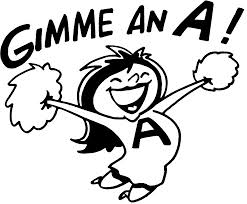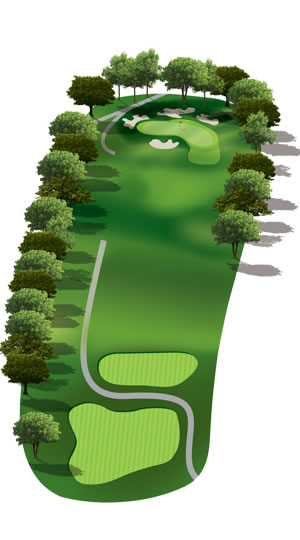PREMISE
Improve your game through your mind
How many of us who have played the game for a long time can recall the feelings we had when we played our first round? This feeling is the beginning of the GPA™, game scoring and improvement system. Golfers Playing Average or GPA™ creates a level field for golfers at all levels to develop confidence in their games. In case you have forgotten how those early rounds felt – here is a little reminder:
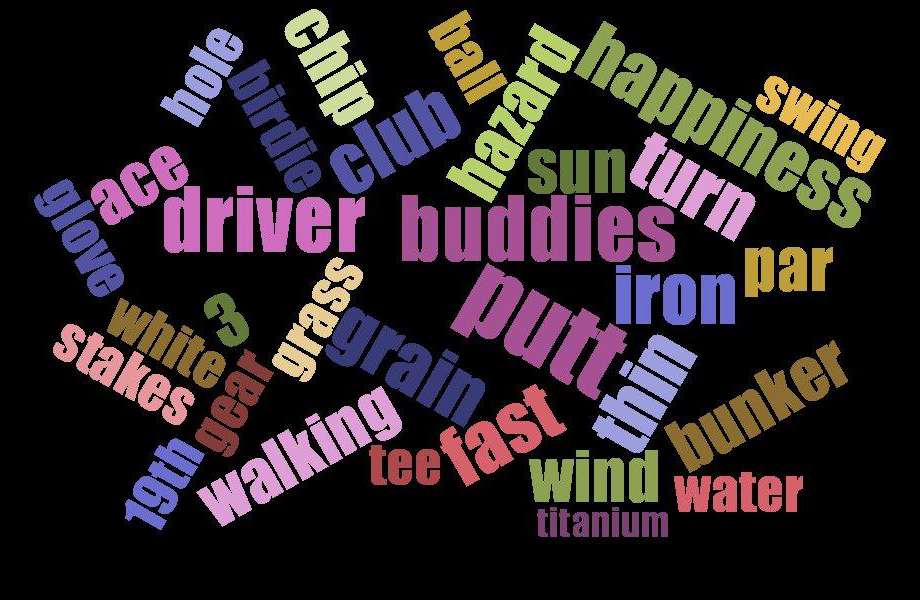
And that’s just a small sample.
As we have seen golf is a game of confidence. A deficit of confidence equates to frustration on the golf course. And who wants to spend time and money simply to walk away frustrated? This is a core reason why golf does not attract or retain more people.
Golf is a difficult game – any of us who play – at any level understand and accept this as a variable
- Multiple variables
- Rules
- Played in a variety of conditions
- With multiple instruments
Golf is a game of confidence
- The more the better
- At every step of the learning process
Golf instruction for a golfer is enhanced when confidence is maximized
- Success is not solely measured by the shot or the scorecard
- Drawing parallels to other learning experiences may boost confidence
- GPA™ liberates the golfer from the scorecard and defines a scoring system which develops confidence
For further consideration:
- Golf is the only game played where less is better.
(The least amount of strokes to the hole (goal) equates to the better score)- No other sport played as a child or adult has this scoring equation.
- Time based activities: running, swimming, cycling feature this equation – yet the competition is against a clock – not par.
- The language of golf cuts across the culture of learning and sports participation where more equates to better
GPA™ harmonizes all past learning experiences and golf scoring becomes consistent and familiar. No longer will the card be a source of frustration as the golfer measures themselves against themselves vs. the score on the card in relation to par.
THEORY
The current scoring system…
- Is confusing to a new player…
- The card itself has too much information for a new player to interpret and incorporate
- Stifles confidence with the occasional reward of par or birdie
- The score card highlights distance away from par – an arbitrary number
- New golfers facing a gap feel intimidated when playing with a better player
- Beginning golfers seeing the difference of their score to par become disillusioned and are more prone to leave the game – minimal rewards for the expenditure of time and money
There is a different way…
- Borrow knowledge management from the academic world
- Define broader skill categories for golfers – loosely based upon the USGA handicap system
- Maintain the notion of par being the number of golf strokes necessary to complete a hole or course by an expert golfer
- Scale the scoring system accordingly
How is knowledge managed in the academic world – a learning environment where we have great familiarity?
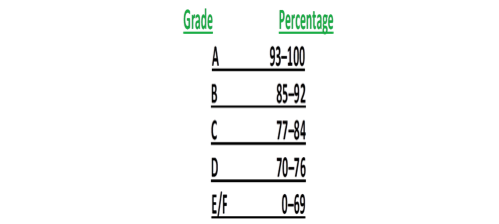
We are all familiar with the scoring / grading system which produces a grade point average. As we know par is a score which is developed by the designer of a course to suggest the most efficient way to get from the tee (Point A) and the bottom of the hole (Point B). A short hole will be a par 3. Generally expected to mean one shot to the green and two putts. This equates to par. Of course one can be shy of the green and chip and then one putt and the score is the same. For a par four? Generally it is two shots to the green and two putts to maximizing efficiency from Point A to point B. A par five generally allows for three shots from Point A and then then two shots to complete Point B.
If we take the academic grading system above and then apply it to the notion of par – meaning this: if maximum accomplishment in an academic course results in an A grade; then the golf equivalent is an A for par.
What is par?
Par n.
In Sports: The number of golf strokes considered necessary to complete a hole or course in expert play.
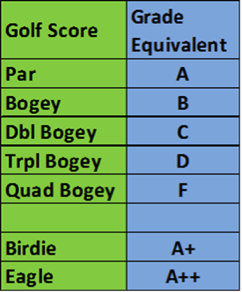
The equivalencies look like this:
What do you think? By drawing a direct parallel between the system of knowledge management we all grew up with and applying it to golf scoring we can then move away from the limiting nature of the scorecard and then move to the arena of learning – becoming a better golfer using a familiar system.
APPLICATION
We start before we begin the round. If you are new to the game or just reacquainting yourself with the game it is very likely that you will score over 100 for 18 holes. Nothing wrong with that at all. In fact? You are to be commended for taking up the game. If you are a more experienced golfer? Ask yourself in general if you shoot under 100 most of the time, or under 90 most of the time, or under 80 most of the time for 18 holes. This is important because it will determine your level and this becomes a foundation for the scoring system.

At present I am a Level 2 golfer. Note I am not discussing handicaps. Right now in general I am scoring under 90. Occasionally I will break 80. An essential degree of comfort with your level is essential to make the golf experience one which builds confidence and assures: “Happiness – One Shot at a Time…”™
Once you have determined your level – 1 thru 4 – we then look at the scorecard differently. Moving from Golf Equivalency in the first chart to GPA™ in the next chart.
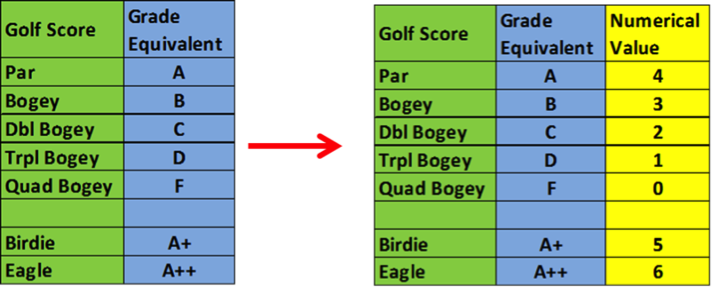
The above charts reflects scoring and grade equivalents for a level 1 player. As mentioned I am a level 2 player and you may be the same or level 3 or 4. So… you may be asking… how do I get an A? Recall the playing level and look below.
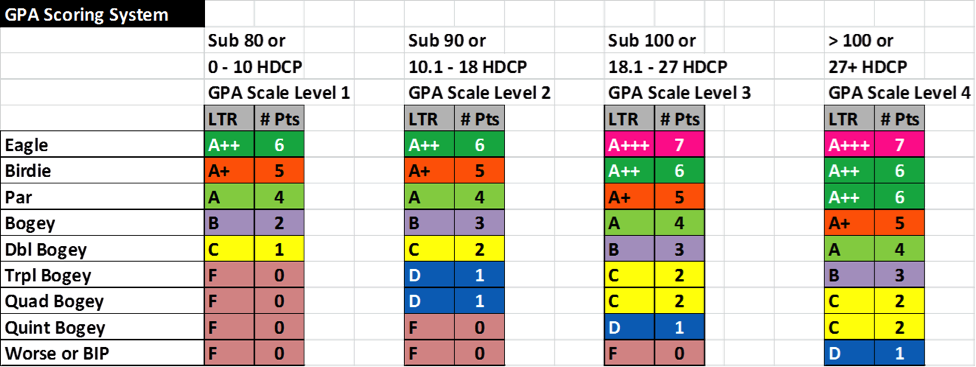
For the beginning golfer achieving an A means scoring a double bogey or a 5 on a par 3, a 6 on a par 4 or a 7 on a par 5. Contrast that to a Level 2 player where an A is scoring a par. The difference between a level 1 and Level 2 player is that a Level 2 playing can still make points after double bogey. Whereas the Level 1 player is not rewarded beyond a double bogey.
Bringing all of the elements together, the chart below will illustrate the GPA™ Scoring system. For the Level 1 or Sub 80 scorer on this particular day they shot an 80 on a Par 72 course. Pretty good I’d say. Quite a few A’s and B’s on the card as well. Converting the letter grades to the numerical equivalents we see the golfer played to a 3.5 out of 4.0 GPA™. If you recall your days as a student and came home with a report card showing a 3.5 cumulative grade point average – you might feel pretty good about yourself. I know I would!

Now say that your playing companion was a Level 3 player, someone who shoots between 90 and 100 frequently. Perhaps a good friend, spouse or perhaps a curious child. You have shot a very nice score of 80, as in the above and they have shot 92. We know in the game of golf a lower score is the better score. We also know that the game has a long learning curve. In this case, looking below, you will note that the Level 3 player despite shooting a higher score had a better GPA™ for the round. Meaning? They may have played closer to the very best they good given the level they play at in this present moment.

Imagine the conversation between the two golfers on their way home or enjoying a meal. The Level 1 player feeling good about their game. The Level 3 player both in relative and comparable terms feeling good about their game. The scorecard leveled. Both golfers gathering a sense of how they did on this day against their ability vs. the arbitrary notion of par. This builds encouragement. Confidence. Happiness….One Shot at a Time.™
OUTCOMES
If you use the GPA™ for three to six months you will likely see a one level improvement. Golfers who have used the system have seen their scores drop from the 120’s to breaking 100. Some golfers have seen their scores drift from high 80’s to lo 80’s. The quest for an “A” becomes ingrained and the resulting satisfaction from achieving an “A” creates residual confidence which results in better scoring.
For the golfer this is a path to Happiness…One shot at a Time.™






